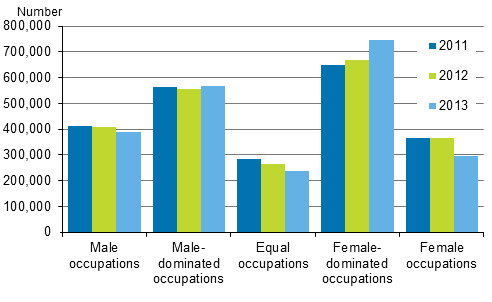Published: 23 October 2015
Professional differentiation by sex continued in 2013
According to Statistics Finland's employment statistics, 10.2 per cent of all employed persons were in 2013 in equal occupational groups, where the share of different sexes among those included in the occupational group is 40 to 60 per cent. The share was 1.2 percentage point smaller than in 2012 and 1.8 percentage points smaller than in 2011. 1)
Number of employed persons in various segregation classes in 2011 to 2013

Professional differentiation by sex, segregation, is based on the classification of occupational groups by gender proportions. The strength of the segregation is determined based on how many employed persons work in equal occupational groups.
Table 1. 5-class segregation classification of occupations
| Segregation class | The occupational groups in which |
| Female occupation | women > 90 % |
| Female-dominated occupation | 60 % < share of women ≤ 90 % |
| Equal occupation | 40 % ≤ share of women / men ≤ 60 % |
| Male-dominated occupation | 60% < share of men ≤ 90 % |
| Male occupation | men > 90% |
In 2013, over 235,800 persons worked in equal occupational groups (Appendix table 1). The most common equal occupational groups were teachers in vocational education (around 16,100 persons), food and related products machine operators (15,700 persons), and advertising and marketing professionals (13,800).
The most common occupational groups where the sex shares were most equally divided (share of women/men 49 to 51 per cent) were food and related products machine operators (15,700), graphic and multimedia designers (3,300), and dairy and livestock workers (2,100).
Decreasing working in equal occupational groups is to some extent explained by the previously equal occupational groups becoming more female or male-dominated (Appendix table 2). In 2012 to 2013, for example, policy administration professionals, judges, and human resource managers became female-dominated occupations. The occupational groups of mail carriers, assemblers of electrical and electronic equipment, and mathematicians, actuaries and statisticians became male-dominated occupations in 2012 to 2013. (Appendix table 3.)
On the other hand, some completely new equal occupational groups were born in 2013. The biggest of these groups were real estate agents and property managers, credit and loan officers, photographers, and authors and related writers.
One in three worked in female-dominated occupations
In 2013, around 750,000 persons worked in female-dominated occupations, or 32.5 per cent of all employed persons. The share was four percentage points higher than in 2012. The most common female-dominated occupations were shop sales assistants (110,000 persons), office cleaners (44,700), and primary school and early childhood teachers (total 44,100).
An increasing share of employed women, 49.4 per cent, worked in female-dominated occupations and a decreasing share, 23.9 per cent, in female occupations in 2013. Of female occupation in 2012, general secretaries, government social benefits officials, and hospital and institutional helpers became female-dominated in 2013.
By contrast, employed men were distributed almost in the same way in segregation classes in 2013 and in 2012. For men, the biggest change occurred in male-dominated occupations, where 1.5 percentage points more of men worked in 2013 than in 2012. The change is, in addition to the above-mentioned increase in male-domination in equal occupational groups, explained by the fact that electrical engineering technicians, manufacturing supervisors, and metal polishers, wheel grinders and tool sharpeners turned from male occupations into male-dominated occupations.
New employed persons, persons changing their occupation, as well as persons moving away from employment affect the changes in the gender distribution of occupational groups.
Of those employed in 2012 altogether 237,800 persons were no longer employed or did not belong to the population in 2013. Most employed persons left male occupations, around 11 per cent. (Appendix table 4.)
Of all employed persons in 2013, some 199,600 were new employed persons. New employed persons were persons who were not employed or did not belong to the population in 2012. The share of new employed persons was the highest, around nine per cent, in female-dominated occupations (Appendix table 5). Altogether, the number of employed persons was around 30,500 lower in 2013 than in 2012.
In Statistics Finland's employment statistics for 2013, the occupations of wage and salary earners and entrepreneurs aged 18 to 74 have been classified into occupational groups according to the Classification of Occupations 2010 2) 3) .
1) The occupational categories of 2011 to 2013 have been harmonised by using the most detailed possible common level.
2) Occupation data are produced primarily based on a person's main employment relationship in the last week of the year.
3) The data on occupations remained unknown for some 2.9 per cent of all employed persons, for some 2.6 per cent of all employed women and for 3.1 per cent of employed men in 2013.
Source: Employment Statistics, Statistics Finland
Inquiries: Elina Mikkelä 029 551 2973, Marketta Oinonen 029 551 3602, tyossakaynti@stat.fi
Director in charge: Jari Tarkoma
Publication in pdf-format (232.3 kB)
- Tables
-
Tables in databases
Pick the data you need into tables, view the data as graphs, or download the data for your use.
Appendix tables
- Appendix table 1. Employed person aged 18 to 74 in segregation classes in 2011 to 2013 1) (23.10.2015)
- Appendix table 2. Shares of employed persons aged 18 to 74 in segregation classes in 2011 to 2013, % 1) (23.10.2015)
- Appendix table 3. The most common occupational group segregation class changes among employed persons aged 18 to 74 in 2012 to 2013 1) (23.10.2015)
- Appendix table 4. Share of those who became non-employed from 2012 to 2013 of employed persons aged 18 to 74 in the segregation class in 2012, % 1) (23.10.2015)
- Appendix table 5. Share of new employed persons of all employed persons aged 18 to 74 in the segregation class in 2013, % 1) (23.10.2015)
Updated 23.10.2015
Official Statistics of Finland (OSF):
Employment [e-publication].
ISSN=2323-6825. Industry, employer sector and jobs 2013. Helsinki: Statistics Finland [referred: 10.3.2025].
Access method: http://stat.fi/til/tyokay/2013/04/tyokay_2013_04_2015-10-23_tie_001_en.html

